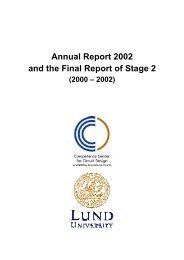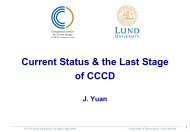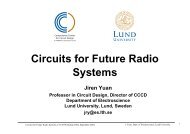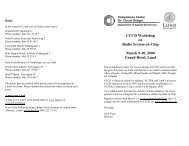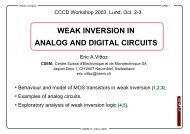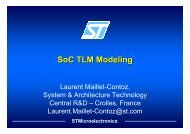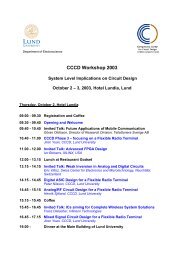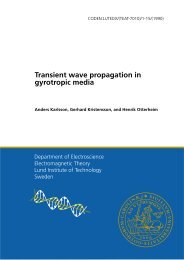Design of Antennas for Handheld DVB-H ... - Lunds tekniska högskola
Design of Antennas for Handheld DVB-H ... - Lunds tekniska högskola
Design of Antennas for Handheld DVB-H ... - Lunds tekniska högskola
You also want an ePaper? Increase the reach of your titles
YUMPU automatically turns print PDFs into web optimized ePapers that Google loves.
There will be no reflection only when the impedance <strong>of</strong> the antenna and the<br />
characteristic impedance <strong>of</strong> the transmission line are equal, then the antenna is<br />
perfectly matched. To achieve good antenna per<strong>for</strong>mance in a wide frequency<br />
range a slight mismatch in the whole band is the best solution. The reflection is<br />
unwanted because a part <strong>of</strong> the power is not delivered into the antenna, in the<br />
transmission case and vice versa in the receiving case. The impedance matching is<br />
an important task in the antenna design. Some basic methods <strong>for</strong> matching are<br />
presented later [25].<br />
The voltage at a point on a transmission line is in the general case the sum <strong>of</strong> two<br />
waves travelling opposite directions. This scenario is known to create a standingwave<br />
pattern along the transmission line. The ratio between the maximum and the<br />
minimum value <strong>of</strong> this sum is termed the voltage standing-wave ratio and can be<br />
calculated from the reflection coefficient with equation 2.4.<br />
1+<br />
Γ<br />
VSWR = (2.4)<br />
1−<br />
Γ<br />
Power loss due to reflection, called reflection loss Lrefl, can be calculated from<br />
1<br />
L refl = 10 log<br />
(2.5)<br />
2<br />
1 − Γ<br />
Return loss describes the ratio between the propagated and the reflected power<br />
and can be calculated from<br />
1<br />
L retn = 10log<br />
(2.6)<br />
2<br />
Γ<br />
VSWR, Lrefl and Lretn are all calculated from the reflection coefficient and they are<br />
normally used to define the impedance bandwidth. In figure 2.9, the bandwidth<br />
BWabs is defined by the absolute value <strong>of</strong> the reflection coefficient Γ ≤ 0.<br />
501,<br />
which corresponds to the return loss criterion <strong>of</strong> Lretn ≥ 6dB<br />
or the VSWR<br />
criterion <strong>of</strong> S ≤ 3.<br />
01.<br />
This limit has to be set in each case separately. Nowadays<br />
Lretn ≥ 6dB<br />
is an acceptable upper limit on the bandwidth criterion <strong>for</strong> built-in<br />
antennas [24].<br />
20



